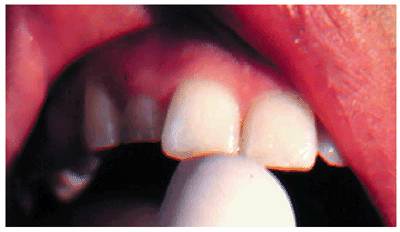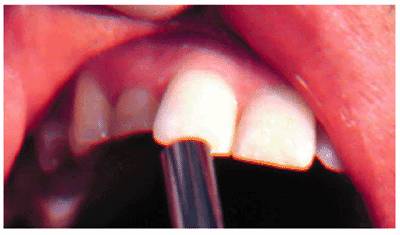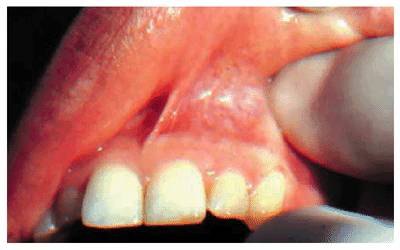ENDODONTICS AND ESTHETIC DENTISTRY(5)
Periapical Tests
Percussion. Gently tapping the forefinger on the incisal or occlusal surface of a tooth may elicit a painful response (Figure 19-18). In situations when the response generated is mild or absent, a more pronounced blow should follow by percussing the tooth with a mirror handle (Figure 19-19).
A painful response usually indicates inflammatory changes in the periodontal ligament that could be caused by pulpal degeneration. When bacteria have entered the pulp, necrosis will follow. Endotoxins from the bacteria will eventually exit the canal and stimulate an inflammation of the periodontal tissue surrounding the apex of the tested tooth. The reaction is usually more intense when the inflammatory condition is of an endodontic rather than a periodontal origin.
Occasionally, painful responses to percussion are elicited from teeth not undergoing pulpal degeneration. Acute sinusitis often causes the maxillary posterior teeth to be painful when percussed. A careful history of the patient's respiratory experiences and allergies is essential in making the differential diagnosis. Teeth in traumatic occlusion are frequently sensitive to percussion but are also painful to cold. To exclude this possibility, a check for occlusal prematurities is indicated. A degenerative pulp does not usually respond to thermal pulp tests unless it is in its most acute stage. If a tooth is painful to both percussion and cold, one should suspect a vertical fracture. These are most frequently observed in mandibular second molars and maxillary bicuspids and occur irrespective of their restorative conditions. The use of the transilluminator or fiber-optic light is quite useful in diagnosing cracked tooth syndrome (see Fig 19-10).
Palpation. Pressure with a gloved forefinger over the apex of a suspected tooth may reveal tissue distention and elicit a painful response (Figure 19-20). This indicates the inflammatory response at the apex. The tender area may be so extensive that the teeth adjacent to the suspected tooth must also be tested. Once again, a differential diagnosis of acute sinusitis should be considered when the maxillary posterior teeth are involved. The tissues painful to palpation with sinusitis usually spread away from the dentition and extend superiorly and facially. Although the area of pain is usually concentrated at the zygomatic process of the maxilla, the pain may extend around the orbit and incite headaches. Pulp testing and a careful history are essential in these situations.

Figure 19-18: The first percussion check is a gentle tap with a gloved fingernail.

Figure 19-19: The second percussion is a gentle tap with a mirror handle.

Figure 19-20: Palpation with the forefinger over a suspected tooth.
TAGS:
0% (0)
0% (10)
Sponsored Links
Daliy Dental Topics
- on 01.11.2012 [endodontics]
- on 01.11.2012 [endodontics]
- on 01.11.2012 [endodontics]
- on 10.13.2011 [endodontics]
- on 12.15.2010 [endodontics]
- on 08.11.2010 [endodontics]
Useful Links
- Long Island College Hospital - [education]
- Faculty of Dental Medicine - H [education]
- The American Association of Or [organize]
- Summer Institute in Clinical D [organize]
- Academy of Osseointegration [organize]
- University of North Carolina a [education]
- American Orthodontic Society [article]
- American Equilibration Society [article]
- Niigata University - Japan [education]
- University of Buffalo [education]